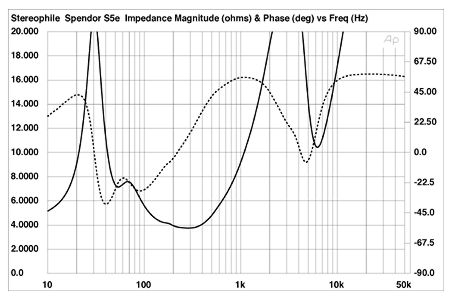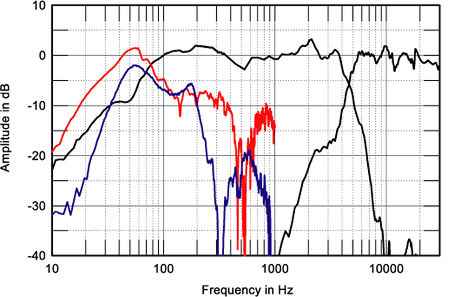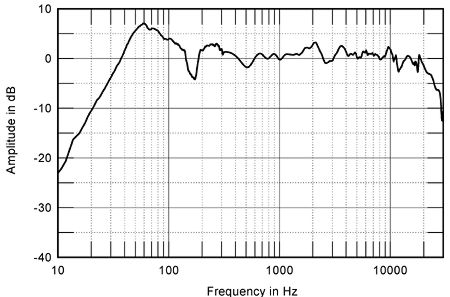| Columns Retired Columns & Blogs |
Spendor S5e loudspeaker Measurements
Sidebar 3: Measurements
With its small drive-units, the Spendor S5e exhibited the expected low sensitivity. I estimated a value of 82.5dB(B)/2.83V/m, which is significantly less than specified. Its impedance plot (fig.1) was unusual in that it had a much higher magnitude in the treble than in the midrange. While the latter ranged between 3.9 and 9 ohms, the impedance above 1kHz didn't drop below 10 ohms, and for much of the time remained above 20 ohms. As a result, if a tube amplifier with a typically high source impedance is used with the Spendor, the speaker's frequency balance will suffer tilted-up high frequencies. The electrical phase angle is generally low to moderate, meaning that the S5e will be a fairly easy speaker for the partnering amplifier to drive.

Fig.1 Spendor S5e, electrical impedance (solid) and phase (dashed). (2 ohms/vertical div.)
A small wrinkle in the impedance traces just below 200Hz suggests the presence of some kind of cabinet resonance at that frequency. However, investigating the panels' vibrational behavior with an accelerometer revealed very little untoward behavior, and nothing at the frequency of the impedance wrinkle. The only significant resonant mode I found lay at 300Hz (fig.2), but as this was on the rear panel, which faces away from the listener, its subjective effect should be minimal.

Fig.2 Spendor S5e, cumulative spectral-decay plot calculated from the output of an accelerometer fastened to the cabinet's rear panel (MLS driving voltage to speaker, 7.55V; measurement bandwidth, 2kHz).
The small saddle at 50Hz in the impedance-magnitude trace suggests that this is the tuning of the port at the base of the cabinet's rear panel, which in turn suggests only modest bass extension. However, the upper of the usual two impedance peaks is almost vestigial, implying that the Spendor has an unusual reflex alignment.
I explore this in fig.3, which shows, on its left-hand side, the nearfield responses of the midbass unit (black trace), woofer (red), and port (blue). The midbass unit does show the usual reflex notch in its low-frequency output, this at 50Hz, as expected from the impedance graph. The port also peaks in this same frequency region, again as expected. However, what I didn't expect was that the woofer would also peak in this region. Most unusual. Remember that wrinkle in the impedance traces just below 200Hz? Note that the port has an apparent second peak in its output in the same region, probably due to a resonance of some kind in the vent.

Fig.3 Spendor S5e, acoustic crossover on tweeter axis at 50", corrected for microphone response, with the nearfield midbass response plotted below 350Hz (black), along with the nearfield responses of the woofer (red) and port (blue) plotted below 1kHz.
The woofer extends higher in frequency than the port, but has a large notch in its output between 400Hz and 700Hz, this coinciding both with a suppressed peak in the port output and a slight suckout in the midbass unit's farfield response. This latter unit peaks up by a couple of dB at the top of its passband before handing over to the tweeter at 4.5kHz, as specified. The tweeter is commendably flat within its passband.
Fig.4 shows how all this adds up in the farfield, averaged, as is my usual practice, across a 30 degrees horizontal window on the tweeter axis. The S5e's balance is quite flat overall, other than a slight energy excess at the top of the woofer's passband. The bass response is rather complex. The 6dB peak between 50 and 90Hz will be due, at least in major part, to the nearfield measurement technique, which assumes a half-space acoustic environment. But the speaker's midbass is still exaggerated, which will give the impression of better LF extension than expected from a design with twin 4" cones. That peak at around 180Hz in the port's output cancels the drive-units' outputs to give a notch in the Spendor's calculated farfield response. This region is also significantly affected by the room acoustics; it's possible that, in-room, the S5e's upper-bass/lower-midrange transition might be more smoothly integrated. However, I note that Art Dudley did find a lack of energy in this region when he first set up the speakers.

Fig.4 Spendor S5e, anechoic response on tweeter axis at 50", averaged across 30 degrees horizontal window and corrected for microphone response, with the complex sum of the nearfield midbass, woofer, and port responses, taking into account acoustic phase and distance from the nominal farfield point, plotted below 300Hz.
The Spendor's lateral dispersion (fig.5) was relatively even, there being only a slight flare at the bottom of the tweeter's passband, due to the midbass unit's increasing directivity above 2kHz. The 1" tweeter also has much better top-octave dispersion than is usually the case, which will have contributed to AD's finding the speaker to have a "pleasantly airy top end." In the vertical plane (fig.6), the S5e maintains its flat response only within a ±5 degrees window centered on the tweeter axis. This is a low 28" from the floor; if the Spendor's tonal balance is not to become a little hollow due to a suckout developing at the crossover frequency, tall listeners might want to experiment with slight amounts of speaker tiltback.

Fig.5 Spendor S5e, lateral response family at 50", normalized to response on tweeter axis, from back to front: differences in response 90 degrees-5 degrees off-axis, reference response, differences in response 5 degrees-90 degrees off-axis.

Fig.6 Spendor S5e, vertical response family at 50", normalized to response on tweeter axis, from back to front: differences in response 20 degrees-5 degrees above axis, reference response, differences in response 5 degrees-15 degrees below axis.
In the time domain, the S5e's step response on the tweeter axis (fig.7) reveals that the tweeter is connected in positive acoustic polarity, the midbass in inverted polarity. However, the steps of each smoothly hand over to one another, confirming the crossover's good frequency-domain performance. Note that some reflections can be seen a few hundred microseconds after the initial move away from the time axis. Examining the step responses of the tweeter and midbass units individually (not shown) revealed that these are due to reflections of the outputs of both drive-units from some aspects of the enclosure. (I measured the speaker outdoors with it atop a 5' stand, so these are not boundary reflections.) As a result, the S5e's farfield waterfall plot (fig.8) looks a bit less tidy than I would have liked. Even so, the graph's initial decay is quite clean through the midrange and treble, correlating with AD's finding the speaker to have "clarity of sound."

Fig.7 Spendor S5e, step response on tweeter axis at 50" (5ms time window, 30kHz bandwidth).

Fig.8 Spendor S5e, cumulative spectral-decay plot at 50" (0.15ms risetime).
AD commented very positively on the Spendor's balance of strengths, and while my eyebrows rose at its unusual woofer alignment, I, too, feel its measured performance offers an excellent balance. It's no speaker for headbangers, but within its dynamic-range limitations, it will offer a bighearted sound.—John Atkinson
- Log in or register to post comments




































